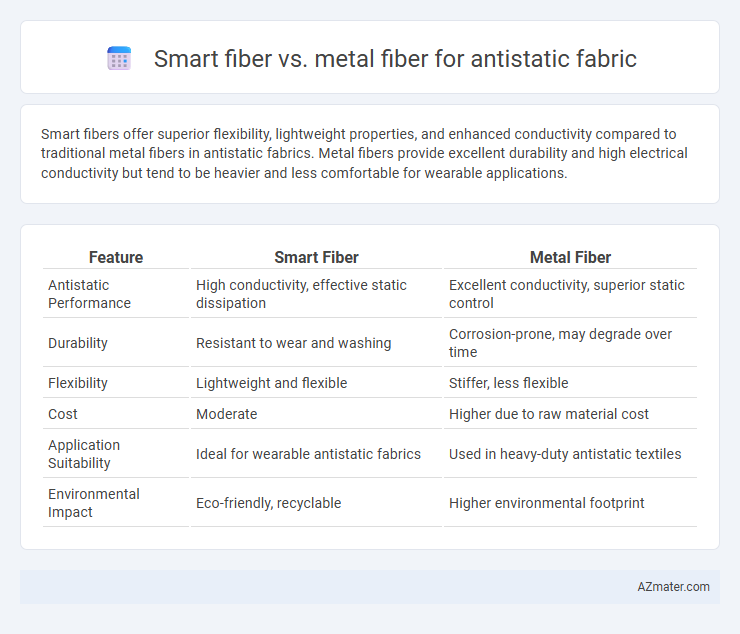Smart fibers offer superior flexibility, lightweight properties, and enhanced conductivity compared to traditional metal fibers in antistatic fabrics. Metal fibers provide excellent durability and high electrical conductivity but tend to be heavier and less comfortable for wearable applications.
Table of Comparison
| Feature | Smart Fiber | Metal Fiber |
|---|---|---|
| Antistatic Performance | High conductivity, effective static dissipation | Excellent conductivity, superior static control |
| Durability | Resistant to wear and washing | Corrosion-prone, may degrade over time |
| Flexibility | Lightweight and flexible | Stiffer, less flexible |
| Cost | Moderate | Higher due to raw material cost |
| Application Suitability | Ideal for wearable antistatic fabrics | Used in heavy-duty antistatic textiles |
| Environmental Impact | Eco-friendly, recyclable | Higher environmental footprint |
Introduction to Antistatic Fabrics
Antistatic fabrics incorporate conductive fibers to dissipate static electricity, preventing electrical discharge that can damage sensitive electronics or cause ignition in flammable environments. Smart fibers, often composed of conductive polymers or carbon-based materials, offer enhanced flexibility and sensing capabilities compared to traditional metal fibers like stainless steel or silver-coated threads. The choice between smart fiber and metal fiber influences the fabric's conductivity, durability, and comfort, making it crucial for applications in electronics manufacturing, cleanrooms, and protective clothing.
Understanding Smart Fiber Technology
Smart fiber technology in antistatic fabrics uses conductive polymers or carbon nanotubes embedded within fibers to provide enhanced static dissipation and durability compared to traditional metal fibers. Unlike metal fibers that can corrode, break, or lose conductivity over time, smart fibers maintain consistent performance through self-healing properties and flexibility. These advanced materials optimize electrical conductivity while preserving fabric comfort, making them ideal for applications requiring reliable static control in sensitive environments.
Overview of Metal Fiber Integration
Metal fiber integration in antistatic fabric involves embedding fine metallic strands, such as stainless steel or copper, within textile fibers to provide superior conductivity and static dissipation. These metal fibers offer high durability, excellent electrical performance, and resistance to wear, making them suitable for environments requiring reliable static control. The integration enhances fabric strength and longevity while maintaining flexibility and comfort in various industrial and electronic applications.
Key Properties of Smart Fiber Antistatic Fabrics
Smart fiber antistatic fabrics exhibit superior conductivity and durability compared to metal fiber counterparts, providing consistent static dissipation under various environmental conditions. These fabrics offer enhanced flexibility and lightweight comfort while maintaining effective electromagnetic interference shielding. Their advanced polymer-based composition ensures resistance to corrosion and abrasion, extending fabric lifespan in demanding industrial applications.
Performance Characteristics of Metal Fiber Antistatic Fabrics
Metal fiber antistatic fabrics offer superior conductivity and rapid dissipation of static charges due to the inherent electrical properties of metals like stainless steel or copper. These fabrics exhibit excellent durability and resistance to wear, maintaining antistatic performance even after repeated laundering and mechanical stress. The high tensile strength and thermal stability of metal fibers further enhance the fabric's protective capabilities in demanding industrial environments.
Durability: Smart Fiber vs Metal Fiber
Smart fiber exhibits superior durability compared to metal fiber in antistatic fabrics due to its enhanced flexibility and resistance to wear, corrosion, and repeated laundering. Metal fibers, often prone to oxidation and mechanical damage, tend to degrade faster under harsh conditions, reducing the fabric's antistatic effectiveness over time. Long-term performance data shows smart fibers maintain consistent conductivity and structural integrity, making them ideal for applications requiring sustained durability and reliability.
Comfort and Wearability Comparison
Smart fibers in antistatic fabrics offer superior breathability and flexibility compared to metal fibers, enhancing overall comfort during extended wear. Metal fiber-based fabrics tend to be stiffer and less adaptable, which can cause discomfort and limit wearability, especially in dynamic or high-movement applications. The advanced conductivity of smart fibers maintains antistatic performance without compromising fabric softness or moisture management, making them ideal for next-generation wearable textiles.
Cost-Effectiveness Analysis
Smart fiber offers superior cost-effectiveness for antistatic fabric applications due to its enhanced conductivity and durability, reducing replacement frequency and maintenance costs. Metal fiber, while initially cheaper, tends to corrode and degrade faster, increasing long-term expenses and compromising fabric performance. Investing in smart fiber technology results in lower total cost of ownership by combining longevity with consistent antistatic properties.
Environmental Impact and Sustainability
Smart fiber antistatic fabrics, made from advanced conductive polymers, offer superior biodegradability and reduced carbon footprint compared to traditional metal fiber fabrics, which rely on resource-intensive mining and metal processing. Metal fibers contribute to higher environmental pollution through energy consumption and potential heavy metal contamination during production and disposal. The sustainability of smart fiber fabrics is enhanced by their recyclability, lower toxicity, and compatibility with eco-friendly manufacturing processes, supporting long-term environmental responsibility.
Applications and Industry Preferences
Smart fiber antistatic fabrics, utilizing conductive polymers and carbon-based materials, are preferred in electronics and cleanroom environments due to their lightweight, flexibility, and excellent static dissipation properties. Metal fiber fabrics, typically incorporating stainless steel or copper fibers, excel in heavy-duty industrial applications such as automotive manufacturing and chemical processing where durability, conductivity, and resistance to harsh conditions are critical. Industries requiring precise control of electrostatic discharge favor smart fibers for sensitive device assembly, while sectors demanding robustness and longevity opt for metal fiber solutions in protective clothing and grounding applications.

Infographic: Smart fiber vs Metal fiber for Antistatic fabric
 azmater.com
azmater.com